Jinjin Gu
Harnessing Diffusion-Yielded Score Priors for Image Restoration
Jul 28, 2025Abstract:Deep image restoration models aim to learn a mapping from degraded image space to natural image space. However, they face several critical challenges: removing degradation, generating realistic details, and ensuring pixel-level consistency. Over time, three major classes of methods have emerged, including MSE-based, GAN-based, and diffusion-based methods. However, they fail to achieve a good balance between restoration quality, fidelity, and speed. We propose a novel method, HYPIR, to address these challenges. Our solution pipeline is straightforward: it involves initializing the image restoration model with a pre-trained diffusion model and then fine-tuning it with adversarial training. This approach does not rely on diffusion loss, iterative sampling, or additional adapters. We theoretically demonstrate that initializing adversarial training from a pre-trained diffusion model positions the initial restoration model very close to the natural image distribution. Consequently, this initialization improves numerical stability, avoids mode collapse, and substantially accelerates the convergence of adversarial training. Moreover, HYPIR inherits the capabilities of diffusion models with rich user control, enabling text-guided restoration and adjustable texture richness. Requiring only a single forward pass, it achieves faster convergence and inference speed than diffusion-based methods. Extensive experiments show that HYPIR outperforms previous state-of-the-art methods, achieving efficient and high-quality image restoration.
PhotoArtAgent: Intelligent Photo Retouching with Language Model-Based Artist Agents
May 29, 2025Abstract:Photo retouching is integral to photographic art, extending far beyond simple technical fixes to heighten emotional expression and narrative depth. While artists leverage expertise to create unique visual effects through deliberate adjustments, non-professional users often rely on automated tools that produce visually pleasing results but lack interpretative depth and interactive transparency. In this paper, we introduce PhotoArtAgent, an intelligent system that combines Vision-Language Models (VLMs) with advanced natural language reasoning to emulate the creative process of a professional artist. The agent performs explicit artistic analysis, plans retouching strategies, and outputs precise parameters to Lightroom through an API. It then evaluates the resulting images and iteratively refines them until the desired artistic vision is achieved. Throughout this process, PhotoArtAgent provides transparent, text-based explanations of its creative rationale, fostering meaningful interaction and user control. Experimental results show that PhotoArtAgent not only surpasses existing automated tools in user studies but also achieves results comparable to those of professional human artists.
Position: Agentic Systems Constitute a Key Component of Next-Generation Intelligent Image Processing
May 21, 2025
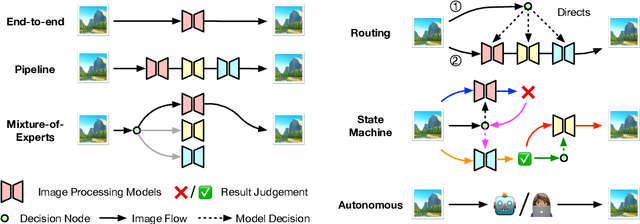
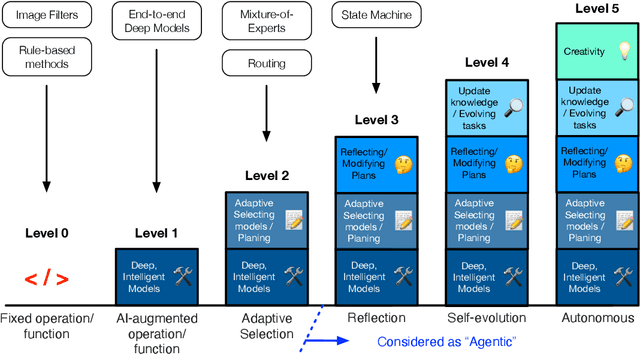
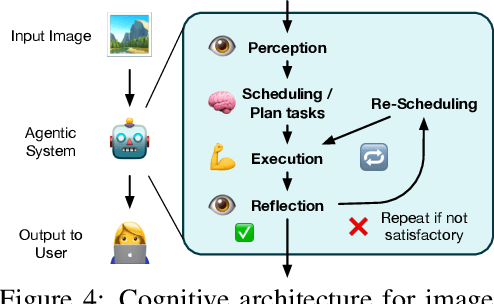
Abstract:This position paper argues that the image processing community should broaden its focus from purely model-centric development to include agentic system design as an essential complementary paradigm. While deep learning has significantly advanced capabilities for specific image processing tasks, current approaches face critical limitations in generalization, adaptability, and real-world problem-solving flexibility. We propose that developing intelligent agentic systems, capable of dynamically selecting, combining, and optimizing existing image processing tools, represents the next evolutionary step for the field. Such systems would emulate human experts' ability to strategically orchestrate different tools to solve complex problems, overcoming the brittleness of monolithic models. The paper analyzes key limitations of model-centric paradigms, establishes design principles for agentic image processing systems, and outlines different capability levels for such agents.
UniCon: Unidirectional Information Flow for Effective Control of Large-Scale Diffusion Models
Mar 21, 2025Abstract:We introduce UniCon, a novel architecture designed to enhance control and efficiency in training adapters for large-scale diffusion models. Unlike existing methods that rely on bidirectional interaction between the diffusion model and control adapter, UniCon implements a unidirectional flow from the diffusion network to the adapter, allowing the adapter alone to generate the final output. UniCon reduces computational demands by eliminating the need for the diffusion model to compute and store gradients during adapter training. Our results indicate that UniCon reduces GPU memory usage by one-third and increases training speed by 2.3 times, while maintaining the same adapter parameter size. Additionally, without requiring extra computational resources, UniCon enables the training of adapters with double the parameter volume of existing ControlNets. In a series of image conditional generation tasks, UniCon has demonstrated precise responsiveness to control inputs and exceptional generation capabilities.
Revisiting the Generalization Problem of Low-level Vision Models Through the Lens of Image Deraining
Feb 18, 2025Abstract:Generalization remains a significant challenge for low-level vision models, which often struggle with unseen degradations in real-world scenarios despite their success in controlled benchmarks. In this paper, we revisit the generalization problem in low-level vision models. Image deraining is selected as a case study due to its well-defined and easily decoupled structure, allowing for more effective observation and analysis. Through comprehensive experiments, we reveal that the generalization issue is not primarily due to limited network capacity but rather the failure of existing training strategies, which leads networks to overfit specific degradation patterns. Our findings show that guiding networks to focus on learning the underlying image content, rather than the degradation patterns, is key to improving generalization. We demonstrate that balancing the complexity of background images and degradations in the training data helps networks better fit the image distribution. Furthermore, incorporating content priors from pre-trained generative models significantly enhances generalization. Experiments on both image deraining and image denoising validate the proposed strategies. We believe the insights and solutions will inspire further research and improve the generalization of low-level vision models.
Teaching Large Language Models to Regress Accurate Image Quality Scores using Score Distribution
Jan 20, 2025



Abstract:With the rapid advancement of Multi-modal Large Language Models (MLLMs), MLLM-based Image Quality Assessment (IQA) methods have shown promising performance in linguistic quality description. However, current methods still fall short in accurately scoring image quality. In this work, we aim to leverage MLLMs to regress accurate quality scores. A key challenge is that the quality score is inherently continuous, typically modeled as a Gaussian distribution, whereas MLLMs generate discrete token outputs. This mismatch necessitates score discretization. Previous approaches discretize the mean score into a one-hot label, resulting in information loss and failing to capture inter-image relationships. We propose a distribution-based approach that discretizes the score distribution into a soft label. This method preserves the characteristics of the score distribution, achieving high accuracy and maintaining inter-image relationships. Moreover, to address dataset variation, where different IQA datasets exhibit various distributions, we introduce a fidelity loss based on Thurstone's model. This loss captures intra-dataset relationships, facilitating co-training across multiple IQA datasets. With these designs, we develop the distribution-based Depicted image Quality Assessment model for Score regression (DeQA-Score). Experiments across multiple benchmarks show that DeQA-Score stably outperforms baselines in score regression. Also, DeQA-Score can predict the score distribution that closely aligns with human annotations. Codes and model weights have been released in https://depictqa.github.io/deqa-score/.
An Intelligent Agentic System for Complex Image Restoration Problems
Oct 23, 2024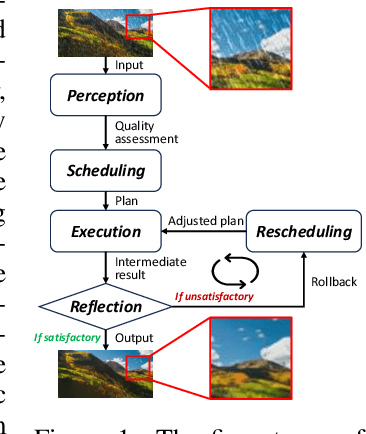
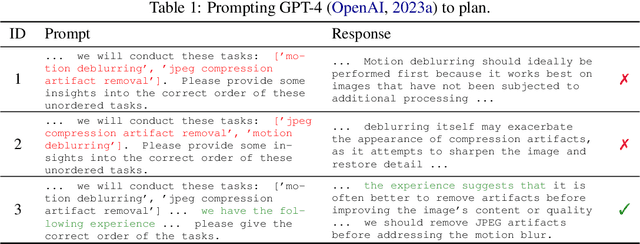
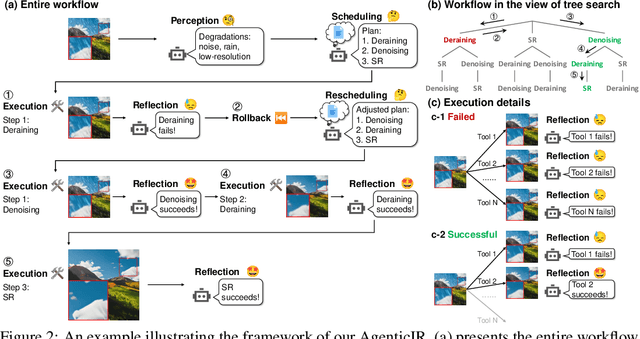
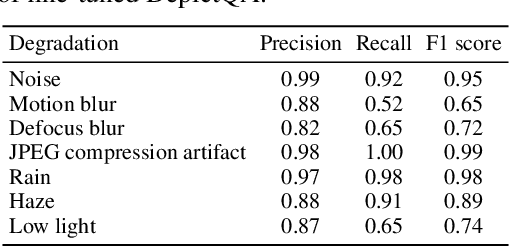
Abstract:Real-world image restoration (IR) is inherently complex and often requires combining multiple specialized models to address diverse degradations. Inspired by human problem-solving, we propose AgenticIR, an agentic system that mimics the human approach to image processing by following five key stages: Perception, Scheduling, Execution, Reflection, and Rescheduling. AgenticIR leverages large language models (LLMs) and vision-language models (VLMs) that interact via text generation to dynamically operate a toolbox of IR models. We fine-tune VLMs for image quality analysis and employ LLMs for reasoning, guiding the system step by step. To compensate for LLMs' lack of specific IR knowledge and experience, we introduce a self-exploration method, allowing the LLM to observe and summarize restoration results into referenceable documents. Experiments demonstrate AgenticIR's potential in handling complex IR tasks, representing a promising path toward achieving general intelligence in visual processing.
Overcoming False Illusions in Real-World Face Restoration with Multi-Modal Guided Diffusion Model
Oct 05, 2024



Abstract:We introduce a novel Multi-modal Guided Real-World Face Restoration (MGFR) technique designed to improve the quality of facial image restoration from low-quality inputs. Leveraging a blend of attribute text prompts, high-quality reference images, and identity information, MGFR can mitigate the generation of false facial attributes and identities often associated with generative face restoration methods. By incorporating a dual-control adapter and a two-stage training strategy, our method effectively utilizes multi-modal prior information for targeted restoration tasks. We also present the Reface-HQ dataset, comprising over 23,000 high-resolution facial images across 5,000 identities, to address the need for reference face training images. Our approach achieves superior visual quality in restoring facial details under severe degradation and allows for controlled restoration processes, enhancing the accuracy of identity preservation and attribute correction. Including negative quality samples and attribute prompts in the training further refines the model's ability to generate detailed and perceptually accurate images.
From News to Forecast: Integrating Event Analysis in LLM-Based Time Series Forecasting with Reflection
Sep 26, 2024



Abstract:This paper introduces a novel approach to enhance time series forecasting using Large Language Models (LLMs) and Generative Agents. With language as a medium, our method adaptively integrates various social events into forecasting models, aligning news content with time series fluctuations for enriched insights. Specifically, we utilize LLM-based agents to iteratively filter out irrelevant news and employ human-like reasoning and reflection to evaluate predictions. This enables our model to analyze complex events, such as unexpected incidents and shifts in social behavior, and continuously refine the selection logic of news and the robustness of the agent's output. By compiling selected news with time series data, we fine-tune the LLaMa2 pre-trained model. The results demonstrate significant improvements in forecasting accuracy and suggest a potential paradigm shift in time series forecasting by effectively harnessing unstructured news data.
A Preliminary Exploration Towards General Image Restoration
Aug 27, 2024



Abstract:Despite the tremendous success of deep models in various individual image restoration tasks, there are at least two major technical challenges preventing these works from being applied to real-world usages: (1) the lack of generalization ability and (2) the complex and unknown degradations in real-world scenarios. Existing deep models, tailored for specific individual image restoration tasks, often fall short in effectively addressing these challenges. In this paper, we present a new problem called general image restoration (GIR) which aims to address these challenges within a unified model. GIR covers most individual image restoration tasks (\eg, image denoising, deblurring, deraining and super-resolution) and their combinations for general purposes. This paper proceeds to delineate the essential aspects of GIR, including problem definition and the overarching significance of generalization performance. Moreover, the establishment of new datasets and a thorough evaluation framework for GIR models is discussed. We conduct a comprehensive evaluation of existing approaches for tackling the GIR challenge, illuminating their strengths and pragmatic challenges. By analyzing these approaches, we not only underscore the effectiveness of GIR but also highlight the difficulties in its practical implementation. At last, we also try to understand and interpret these models' behaviors to inspire the future direction. Our work can open up new valuable research directions and contribute to the research of general vision.
 Add to Chrome
Add to Chrome Add to Firefox
Add to Firefox Add to Edge
Add to Edge